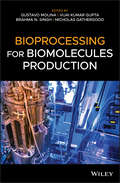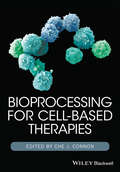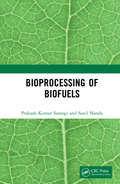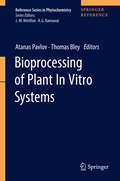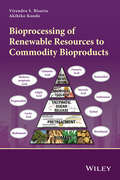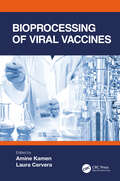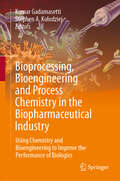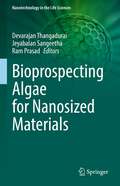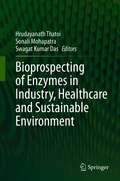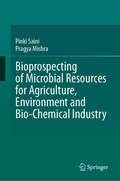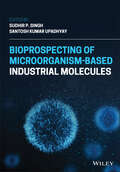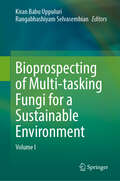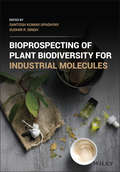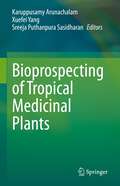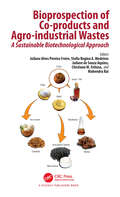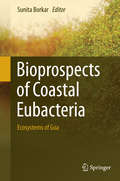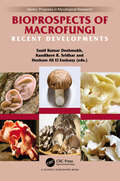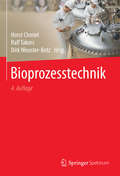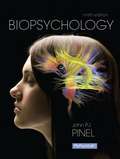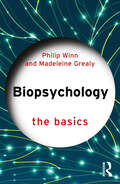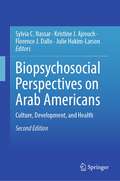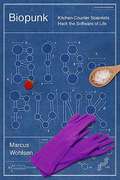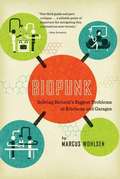- Table View
- List View
Bioprocessing for Biomolecules Production
by Gustavo MolinaPresents the many recent innovations and advancements in the field of biotechnological processes This book tackles the challenges and potential of biotechnological processes for the production of new industrial ingredients, bioactive compounds, biopolymers, energy sources, and compounds with commercial/industrial and economic interest by performing an interface between the developments achieved in the recent worldwide research and its many challenges to the upscale process until the adoption of commercial as well as industrial scale. Bioprocessing for Biomolecules Production examines the current status of the use and limitation of biotechnology in different industrial sectors, prospects for development combined with advances in technology and investment, and intellectual and technical production around worldwide research. It also covers new regulatory bodies, laws and regulations, and more. Chapters look at biological and biotechnological processes in the food, pharmaceutical, and biofuel industries; research and production of microbial PUFAs; organic acids and their potential for industry; second and third generation biofuels; the fermentative production of beta-glucan; and extremophiles for hydrolytic enzymes productions. The book also looks at bioethanol production from fruit and vegetable wastes; bioprocessing of cassava stem to bioethanol using soaking in aqueous ammonia pretreatment; bioprospecting of microbes for bio-hydrogen production; and more. Provides up to date information about the advancements made on the production of important biotechnological ingredients Complete visualization of the general developments of world research around diverse products and ingredients of technological, economic, commercial and social importance Investigates the use and recovery of agro-industrial wastes in biotechnological processes Includes the latest updates from regulatory bodies for commercialization feasibility Offering new products and techniques for the industrial development and diversification of commercial products, Bioprocessing for Biomolecules Production is an important book for graduate students, professionals, and researchers involved in food technology, biotechnology; microbiology, bioengineering, biochemistry, and enzymology.
Bioprocessing for Cell-Based Therapies
by Che J. ConnonWith contributions from leading, international academics and industrial practitioners, Bioprocessing for Cell-Based Therapies explores the very latest techniques and guidelines in bioprocess production to meet safety, regulatory and ethical requirements, for the production of therapeutic cells, including stem cells. An authoritative, cutting-edge handbook on bioprocessing for the production of therapeutic cells with extensive illustrations in full colour throughout An authoritative, cutting-edge handbook on bioprocessing for the production of therapeutic cells with extensive illustrations in full colour throughout In depth discussion of the application of cell therapy including methods used in the delivery of cells to the patient Includes contributions from experts in both academia and industry, combining a practical approach with cutting edge research The only handbook currently available to provide a state of the art guide to Bioprocessing covering the complete range of cell-based therapies, from experts in academia and industry
Bioprocessing of Biofuels
by Prakash Kumar Sarangi Sonil NandaThe major issues relating to environmental sustainability such as a heavy dependency on fossil fuels, increased greenhouse gas emissions, pollution, global warming and climate change have prompted many efforts around the globe to seek alternative energy sources that have negligible environmental impacts and societal benefits. There is an immense interest in biofuels research throughout the world owing to its massive potential to address environmental concerns. Biofuels have the capacity to supplement current and future energy demands through being blended with fossil fuels or even replacing them completely as drop-in fuels in automobiles as well as for heating and the power industries. Waste biomass, primarily lignocellulosic biomass (e.g. agricultural crop residues, forestry biomass and energy crops) and microalgae can act as some inexpensive renewable bioresources for the production of biofuels and biochemicals. The prime focus of Bioprocessing of Biofuels is to shed light on this significant process, especially through microbial conversion technologies to recover and transform the inedible polysaccharides into hydrocarbon biofuels and bioenergy. The book offers introductory coverage of the most crucial topics as follows: A systematic overview of the state-of-the-art in the production and utilization of biofuels Categorical bioprospecting of bioresources for biofuel production Biomass pretreatment and enzymatic saccharification Bioconversion of waste biomass and algae to liquid and gaseous biofuels New developments in microbial fuel-cell technologies Bioprocessing of Biofuels unites topics related to the cutting-edge applications of bioresources and green technologies to reinvigorate biorefineries, positioning them within a competitive energy market. Written to be instantly applicable, this volume offers a reference book for undergraduate and graduate students, scientific investigators and research scholars around the globe working in the areas relating to energy and fuels.
Bioprocessing of Plant In Vitro Systems (Reference Series In Phytochemistry Ser.)
by Thomas Bley Atanas PavlovThis handbook presents how plant in vitro technologies can overcome current limitations in the production of important plant-derived substances. It explains the advantages of plant in vitro technologies, notably the independence from climatic and soil conditions and the ability to synthesize diverse bioactive substances under controlled conditions. Apart from making diverse metabolites, which can be used e.g. as pharmaceuticals, agrochemicals, flavors, colors, biopesticides or food additives, more easily and more efficiently available, the methods described in this handbook also offer the advantage that rare and threatened plants, which provide access to interesting and desired substances, can be better protected, when the substances are harvested from suitable plant in vitro systems. In times of increasing demand for natural plant-derived products, the described methodologies will be key to ensuring efficient and sustainable access to plant-derived products. They will also help and support in the research and investigation of plant secondary metabolites.Despite these advantages, still only few substances are being produced at industrial scale by in vitro plant cell cultivation systems to date. This handbook therefore advertises the recent achievements and research in the field, focused on solving limitations in yield and bioprocessing conditions. Leading experts summarize the methodology, which can help overcome drawbacks like low yields of target products or problems associated with the cultivation in bioreactors. Readers will find comprehensive information on fundamentals for using different types of plants in vitro as matrix for sustainable production of valuable secondary metabolites. The handbook summarizes the core information on phytochemistry, bioreactor technology and monitoring of plant cells and tissues in bioprocesses. It also discusses selected applications and safety assessment of food and cosmetic ingredients from plant cell and tissue.
Bioprocessing of Renewable Resources to Commodity Bioproducts
by Virendra S. Bisaria Akihiko KondoThis book provides the vision of a successful biorefinery—the lignocelluloic biomass needs to be efficiently converted to its constituent monomers, comprising mainly of sugars such as glucose, xylose, mannose and arabinose. Accordingly, the first part of the book deals with aspects crucial for the pretreatment and hydrolysis of biomass to give sugars in high yield, as well as the general aspects of bioprocessing technologies which will enable the development of biorefineries through inputs of metabolic engineering, fermentation, downstream processing and formulation. The second part of the book gives the current status and future directions of the biological processes for production of ethanol (a biofuel as well as an important commodity raw material), solvents (butanol, isobutanol, butanediols, propanediols), organic acids (lactic acid, 3-hydroxy propionic acid, fumaric acid, succinic acid and adipic acid), and amino acid (glutamic acid). The commercial production of some of these commodity bioproducts in the near future will have a far reaching effect in realizing our goal of sustainable conversion of these renewable resources and realizing the concept of biorefinery. Suitable for researchers, practitioners, graduate students and consultants in biochemical/ bioprocess engineering, industrial microbiology, bioprocess technology, metabolic engineering, environmental science and energy, the book offers: Exemplifies the application of metabolic engineering approaches for development of microbial cell factories Provides a unique perspective to the industry about the scientific problems and their possible solutions in making a bioprocess work for commercial production of commodity bioproducts Discusses the processing of renewable resources, such as plant biomass, for mass production of commodity chemicals and liquid fuels to meet our ever- increasing demands Encourages sustainable green technologies for the utilization of renewable resources Offers timely solutions to help address the energy problem as non-renewable fossil oil will soon be unavailable
Bioprocessing of Viral Vaccines
by Amine Kamen Laura CerveraThis book focuses on cell culture-produced viral vaccines to meet the needs of the rapidly expanding research and development in academia and industry in the field. This book introduces the basic principles of vaccination and the manufacturing of viral vaccines. Bioprocessing of Viral Vaccines, will provide an overview of the advanced strategies needed to respond to the challenges of new and established viral infection diseases. The first few chapters cover the basics of virology and immunology as essential concepts to understand the function and design of viral vaccines. The core of the content is dedicated to process development, including upstream processing and cell culture of viral vaccines, downstream processing, and extensive analytical technologies specific to viral vaccines. Advanced process analytical technologies (PAT) and Quality by Design (QbD) concepts are also introduced in the context of vaccine manufacturing. The case studies included cover inactivated, attenuated vaccines exemplified by influenza vaccines, sub-unit vaccines exemplified by Virus Like Particles (VLPs: HPV vaccines) and sub-unit vaccines (Flublock), vectored vaccines: adenoviruses and Vesicular stomatitis Virus (VSV) vectored vaccines, genomic vaccines (DNA and mRNA) vaccines as developed for COVID-19 response in particular and a review of COVID-19 vaccines approved or in advanced clinical trials. This book is aimed at graduate engineers and professionals in the fields of vaccinology, bioprocessing, and biomanufacturing of viral vaccines.
Bioprocessing, Bioengineering and Process Chemistry in the Biopharmaceutical Industry: Using Chemistry and Bioengineering to Improve the Performance of Biologics
by Kumar Gadamasetti Stephen A. KolodziejThis book outlines how advances in the diverse scientific and engineering disciplines of synthetic biology, DNA synthesis, production of protein therapeutics, and bioinformatics have led to the commercialization of new complex biotherapeutic modalities in modern era, including monoclonal and multi-specific antibodies, antibody drug conjugates (ADC), fusion proteins, CAR-T and CRISPR technologies and applications, mRNA vaccines and more. Enabling operations to bring these life-changing medicines into the hands of the needy patients include regulatory submissions to authorities across the globe, as well as streamlined production across manufacturing networks deemed necessary and are outlined in dedicated chapters. Bioprocessing, Bioengineering and Process Chemistry in the Biopharmaceutical Industry: Using Chemistry and Bioengineering to Improve the Performance of Biologics captures the state of the art for many of these new modalities, offering innovative approaches to treat, prevent, and in some providential cases, cure the disease. This book will be of significant interest for many disciplines engaged jointly as teams convergently in delivering these medicines: bioprocess engineers, biologists, chemists, bioengineers, genetic engineers, healthcare professionals, regulatory bodies, among pharmaceutical industry professionals as well as in academic circles.
Bioprospecting Algae for Nanosized Materials (Nanotechnology in the Life Sciences)
by Jeyabalan Sangeetha Ram Prasad Devarajan ThangaduraiAlgae are simple, primitive, heterogeneous, autotrophic, eukaryotic or prokaryotic organisms that lead a symbiotic, parasitic or free-living mode of life. Microalgae and macroalgae possess great potential in various fields of application. Microalgae are ubiquitous and extremely diverse microorganisms that can accumulate toxic contaminants and heavy metals from wastewater, making them a superior candidate to become a powerful nanofactory. Algae were discovered to reduce the presence of metal ions, and afterwards aid in the biosynthesis of nanoparticles. Since algae-mediated biogenic nanoparticles are eco-friendly, cost-effective, high-yielding, speedy and energy-efficient, a large number of studies have been published on them in the last few years. This book focuses on recent progress on the utilization of algae for the synthesis of nanoparticles, their characterization and the possible mechanisms involved. Bioprospecting Algae for Nanosized Materials describes the synthesis of algal nanomaterials and its application in various fields for sustainable development. This book outlines the procedures to prepare phyconanomaterials, techniques to utilize the nanomaterials, and applications in agriculture, environment and medicine.
Bioprospecting of Enzymes in Industry, Healthcare and Sustainable Environment
by Swagat Kumar Das Hrudayanath Thatoi Sonali MohapatraThe rapid urbanization and industrialization of developing countries across the globe have necessitated for substantial resource utilization and development in the areas of Healthcare, Environment, and Renewable energy. In this context ,this resourceful book serves as a definitive source of information for the recent developments in application of microbial enzymes in various sectors. It covers applications in fermentation processes and their products, extraction and utilisation of enzymes from various sources and their application in health and biomass conversion for production of value added products. Different chapters discuss various areas of bioprospecting in enzyme technology, and describe why these are the mainstays for industrial production of value added products. The rich compilation of the cutting-edge advances and applications of the modern industrial based techniques hold feasible solutions for a range of current issues in enzyme technology.This book will be of particular interest for scientists, academicians, technical resource persons, engineers and members of industry. Undergraduate and graduate students pursuing courses in the area of industrial biotechnology will find the information in the book valuable. General readers having interest towards biofuels, enzyme technology, fermented food and value added products, phytochemicals and phytopharmaceutical products will also find the book appealing. Readers will discover modern concepts of enzymatic bioprocess technology for production of therapeutics and industrial value added products.
Bioprospecting of Microbial Resources for Agriculture, Environment and Bio-chemical Industry
by Pragya Mishra Pinki SainiRecent years have seen a sharp rise in novel resistant pathogenic microorganisms. Bioprospecting, or the systematic identification, evaluation and exploitation of the diversity of life in a certain place, is a means of mining microorganisms for what is known as exploitable biology, or valuable genetic information. This information can then be used in the development of novel antibiotics, enzymes, food sources, and energy sources, all of which are of pressing industrial interest across agricultural, nutraceutical, pharmaceutical, biomedical and bioenergetic fields. Microbe-derived bioactive compounds are currently of significant use to the development of sustainable approaches in environmental protection efforts. However, production challenges currently pose a barrier to the large-scale commercialization of microbe-derived products. Bioprospecting of Microbial Resources for Agriculture, Environment and Bio-Chemical Industry is a much-needed review of the current achievements and emerging challenges facing the field of microbe-derived compound production. It covers established knowledge while also proposing solutions to various limitations,and introducing the application of microbe-based products in pollution control and the development of greener technologies. As the preservation of global biodiversity and the production of novel antibiotics are both of significant importance to researchers and the general public alike, this text offers a timely and comprehensive look into the many uses of microbial products across industries. Specific uses covered in the text include the microbial-based recovery of metals for e-waste, the use of microbial nanowires in bioenergy applications, and omics-based technologies in bioprospecting.Through a comprehensive investigation into the current and emerging research on microbial bioprospecting, this text will expand possibilities for the application of microbial resources nutraceutical, pharmaceutical, biomedical and bioenergetic fields. It offers valuable insights for administrators, policy makers, and consultants. It is also a helpful guide for researchers and students in the areas of microbiology, microbial prospecting, food and plant biotechnology, industrial microbiology, biochemical engineering and environmental science.
Bioprospecting of Microorganism-Based Industrial Molecules
by Sudhir P. Singh Santosh Kumar UpadhyayDiscover a comprehensive and current overview of microbial bioprospecting written by leading voices in the field In Bioprospecting of Microorganism-Based Industrial Molecules, distinguished researchers and authors Sudhir P. Singh and Santosh Kumar Upadhyay deliver global perspectives of bioprospecting of biodiversity. The book covers diverse aspects of bioprospecting of microorganisms demonstrating biomass value of nutraceutical, pharmaceutical, biomedical, and bioenergetic importance. The authors present an amalgamation of translational research on bioresource utilization and ecological sustainability that will further the reader’s knowledge of the applications of different microbial diversity and reveal new avenues of research investigation. Readers will also benefit from: A thorough introduction to microbial biodiversity and bioprospecting An exploration of anti-ageing and skin lightening microbial products and microbial production of anti-cancerous biomolecules A treatment of UV protective compounds from algal biodiversity and polysaccharides from marine microalgal sources Discussions of microbial sources of insect toxic proteins and the role of microbes in bio-surfactants production Perfect for academics, scientists, researchers, graduate and post-graduate students working and studying in the areas of microbiology, food biotechnology, industrial microbiology, plant biotechnology, and microbial biotechnology, Bioprospecting of Microorganism-Based Industrial Molecules is an indispensable guide for anyone looking for a comprehensive overview of the subject.
Bioprospecting of Multi-tasking Fungi for Therapeutic Applications: Volume II
by Rangabhashiyam Selvasembian Kiran Babu UppuluriThis book covers the multi-tasking nature of fungi for therapeutic applications. It emphasizes the simultaneous metabolic activities and functions of fungi for producing enzyme inhibitors, therapeutic molecules and other biomedical utilities like polymers, nano-composites and biosensors. The fungi are involved in the production of many therapeutically-potent secondary metabolites and polymers. The recent research on fungal bioprospecting is more focused on sustainable solutions for diverse industries and markets for the circular economy. This book also offers current and future research perspectives of fungal bioprospecting. The potential of fungi to act as a bioresource for antimicrobial, antiviral, anticancer, antiprotozoal and antituberculosis compounds has also been discussed. This book is a reference material for undergraduate students for gaining in-depth knowledge on fungal bioprospecting, particularly fungi's multi-tasking nature.
Bioprospecting of Multi-tasking Fungi for a Sustainable Environment: Volume I
by Rangabhashiyam Selvasembian Kiran Babu UppuluriThis book highlights the types and importance of multitasking fungi and provides critical analysis of fungi involved in production of important enzymes. It also covers additional tasks of fungi such as biosorption, remediation, soil fertilization, and water treatment. This book discusses the types of fungi, their cultivation, execution of multitasking, and the analysis and recovery of products. This information can be used to understand and improve the effectiveness and efficiency of fungi in the production of a variety of products, such as antibiotics, enzymes, and biofuels. This book would be of interest to researchers working in industrial biotechnology, fungal physiology, environmental sciences and technology, sustainable technologies, and agricultural sciences.
Bioprospecting of Plant Biodiversity for Industrial Molecules
by Sudhir P. Singh Santosh Kumar UpadhyayBIOPROSPECTING OF PLANT BIODIVERSITY FOR INDUSTRIAL MOLECULES A comprehensive collection of recent translational research on bioresource utilization and ecological sustainability Bioprospecting of Plant Biodiversity for Industrial Molecules provides an up-to-date overview of the ongoing search for biodiverse organic compounds for use in pharmaceuticals, bioceuticals, agriculture, and other commercial applications. Bringing together work from a panel of international contributors, this comprehensive monograph covers natural compounds of plants, endophyte enzymes and their applications in industry, plant bioprospecting in cosmetics, marine bioprospecting of seaweeds, and more. Providing global perspectives on bioprospecting of plant biodiversity, the authors present research on enzymes, mineral micro-nutrients, biopesticides, algal biomass, and other bioactive molecules. In-depth chapters assess the health impacts and ecological sustainability of the various biomolecules and identify existing and possible applications ranging from ecological restoration to production of essential oils and cosmetics. Other topics include, bio-energy crops as alternative fuel resources, the role of plants in phytoremediation of industrial waste, and the industrial applications of endophyte enzymes. This comprehensive resource: Includes a through introduction to plant biodiversity and bioprospecting Will further the knowledge of application of different plants and improve research investigation techniques. Summarizes novel approaches for researchers in food science, microbiology, biochemistry, and biotechnology Bioprospecting of Plant Biodiversity for Industrial Molecules is an indispensable compendium of biological research for scientists, researchers, graduate and postgraduate students, and academics in the areas of microbiology, food biotechnology, industrial microbiology, plant biotechnology, and microbial biotechnology.
Bioprospecting of Tropical Medicinal Plants
by Xuefei Yang Karuppusamy Arunachalam Sreeja Puthanpura SasidharanThis book focuses on natural products, in particular medicinal plants and their derived products, as an indispensable source of bioactive molecules that serve as either drug candidates or lead compounds for drug design and discovery . There are several advantages for plant-derived therapeutics, including wide availability, diverse pharmacological actions, and a generally good profile of safety and tolerability. Over the recent years, there have been numerous reports from clinical studies testifying the efficacy and safety of medicinal plants and phytochemicals in treating human diseases. A plethora of basic studies has also unraveled molecular mechanisms underlying the health benefits of herbal medicines. Nevertheless, issues such as identification of bioactive ingredients, standardization of the products, and drug interactions remain to be systematically documented. Bioprospecting of Tropical Medicinal Plants represents a comprehensive analysis of natural products, mainly medicinal plants and phytochemicals. It includes detailed medicinal properties and pharmacological action from in vitro models to clinical trials. The goal is to present the readers a carefully curated collection of plant-derived natural products and their underlying molecular mechanisms.
Bioprospecting: Success, Potential and Constraints (Topics in Biodiversity and Conservation #16)
by Russell Paterson Nelson LimaThis book considers all aspects of bioprospecting in 14 succinct chapters and a forward by David Hawksworth. The organisms addressed include plants, insects, fungi, bacteria and phages. Bioprospecting has never been more relevant and is of renewed interest, because of the extremely worrying rise in novel, resistant pathogenic microorganisms. The practices in pharmaceutical companies have failed to deliver novel antibiotics to control these infections. We need to look for new sources of drugs from the environment on a massive scale as drug discovery is "too important to fail". Furthermore, the field can add great value to ecosystems in terms of economics, while providing additional reasons for maintaining associated services, such as food provision, benign climate, effective nutrient cycling and cultural practices. Bioprospecting provides another reason why climate change must be reduced in order to preserve relevant environments. Previous bioprospecting projects should be re-visited and established biodiversity centres have a major role. Many different ecosystems exist which contain unique organisms with the potential to supply novel antibiotics, enzymes, food, and cosmetics, or they may simply have aesthetic value. The book stresses the difficulties in obtaining successful products and yet describes why natural products should be investigated over combinatorial chemistry. Personal experience of bioprospecting projects are given significance. Issues such as how to share the benefits equitably with local communities are described and why pharmaceutical companies can be reluctant to be involved. Legal issues are discussed. Finally, there has never been a better time for a new book on bioprospecting, because of the need to preserve ecosystems, and from the emergence of resistant pathogenic microorganisms.
Bioprospection of Co-products and Agro-industrial Wastes: A Sustainable Biotechnological Approach
by Mahendra Rai Chistiane M. Feitosa Joilane Alves Pereira Freire Stella Regina A. Medeiros Jailane de Souza AquinoThe proposed book titled as “Bioprospection of Coproducts and Agro-industrial Wastes: A Sustainable Biotechnological Approach”, seeks to offer the importance of the recycling, reuse of food residue, byproducts of fruits and agri-wastes to the academic community and industries. In developing countries facing malnutrition and environmental problems, this book would be very useful. The food waste and the residues resulting from this process are now becoming environmental problems. These mainly include leaves, stems, seeds, bark, and roots that have high nutritional value, many times even greater than the part usually consumed. It is a pressing priority to reuse and recycle the waste which is detrimental to the environment. This book would be an essential reading for students, researchers, and people from the food and pharma industry.
Bioprospects of Coastal Eubacteria: Ecosystems of Goa
by Sunita BorkarThis book is a collection of scholarly articles presenting the research results of work carried out under the supervision of Prof. Saroj Bhosle, a microbiologist at Goa University, India. The objective of this volume is to document the comprehensive ecological knowledge of eubacteria isolated from diverse coastal ecosystems of Goa, little explored for microbiological studies. These ecosystems need to be properly tapped in order to reveal potential bacteria yet to be exploited. The topics of this book are particularly relevant to researchers and students in the field of microbiology with an interest in the varied aspects of eubacteria. They provide academic insight for scientific communities in Goa and the rest of the world.
Bioprospects of Macrofungi: Recent Developments (Progress in Mycological Research)
by Sunil Kumar Deshmukh Kandikere R. Sridhar Hesham Ali El EnshasyThe discipline of mycology is a fascinating one. It has a major influence on the nutrition, health and environmental safety of mankind. Cultivation of edible and non-edible mushrooms for nutrition, pharmaceuticals, biopolymers and biocomposites will open up new avenues in research as well as the more profitable utilization of agricultural residues. Cultivation and of domesticated and wild mushrooms poses a challenge to fulfill the needs of human/animal nutrition and utilization of agrowastes tangibly. Cultivation of ectomycorrhizal fungi benefits nutrition as well as plant protection. Macrofungi are the major source of several metabolites of nutritional, health, agricultural and industrial significance (e.g., antioxidants, antimicrobials and pigments). Macrofungal bio composites provide alternatives to the use of animal-derived or plant-derived products (e.g., nanopapers, leather and packaging materials). They serve a dual role in providing nutrition and pharmaceuticals (nutraceuticals) to humans as well as livestock. Macrofungi interact with insects symbiotically (e.g., Termitomyces with termites) and provide delicious nutraceutical product. They also control insects by infecting and producing pharmaceutically and metabolite-rich products (e.g., Cordyceps attacks insects). Macrofungi have a strong potential to control pathogens like nematodes in soil (bioremediation). They are also useful as biofertilizers to meet the needs of plant nutrition. The book outlines current advances in macrofungal technology. It highlights different facets of macrofungal cultivation, bioactive compounds, biocomposites, nutraceuticals, benefits with interaction with insects, application as biofertilizers and ecosystem services like bioremediation.
Bioprozesstechnik
by Ralf Takors Wolfgang Zettlmeier Horst Chmiel Dirk Weuster-BotzDieses Werk wurde erstmals 1991 von Horst Chmiel herausgegeben und hat sich inzwischen als Standardwerk sowohl im Studium als auch in der Praxis der Biotechnologie etabliert. Die in weiten Teilen neue 4. Auflage des Lehrbuchs Bioprozesstechnik bietet eine umfassende Einführung zu allen Aspekten der modernen Bioprozesstechnik. Am Anfang stehen Beiträge zur Kinetik von Enzymen und Mikroorganismen, gefolgt von einem Kapitel zu Prozessmodellen. Weitere Beiträge beschäftigen sich mit den Fließeigenschaften von Biosuspensionen und deren Einfluss auf Transportvorgänge. Die Funktionsweise von Bioreaktoren und das Problem der Sterilität sowie die Mess- und Regeltechnik werden ausführlich behandelt. Oftmals entfallen mehr als die Hälfte der Kosten eines Bioprodukts auf die Aufarbeitung, ihr wird deshalb besondere Beachtung geschenkt. Der Beschreibung von ausgewählten Bioprozessen sind drei Kapitel gewidmet, bevor das Buch mit einem Beitrag zu systembiologischen Aspekten der Bioprozesstechnik abgeschlossen wird.
Biopsychology
by John P. J. PinelDelves into how the central nervous system governs behavior Biopsychology, 9/e, introduces the study of the biology of behavior; that is, the neural mechanisms of psychological processes in the central nervous system. This program combines biopsychogical science and student-oriented discussion, interweaving the basics of this specialized field with clinical case studies and exploring the personal and social implications that arise. The author encourages interactive learning and creative thinking. His clear and engaging presentation makes the material personally and socially relevant to readers.
Biopsychology: The Basics (The Basics)
by Philip Winn Madeleine GrealyBiopsychology: The Basics is a concise, accessible and illuminating introduction to the field of biopsychology. The book explores what psychology is in the broadest sense and how combining it with a biological perspective offers a deeper understanding of behavior and mental life. Key topics include the following:• What biopsychology is: understanding the interaction of biology and psychology• The biology of the brain and how to study it• How psychological states are related to physiological processes• The effects of drugs, both therapeutic and recreational, on behaviour and psychology• How genes and the environment impact psychological development• The biopsychology of cognition• People in the world: understanding emotions, motivation and communication• The biological basis of psychopathologies – causes, diagnoses and treatments• Explanations, mechanisms and the biopsychology of consciousnessWith suggestions for further reading and an extensive glossary of key terms, this book is an engaging and ideal introduction for those coming to the subject for the first time.
Biopsychosocial Perspectives on Arab Americans: Culture, Development, and Health
by Kristine J. Ajrouch Julie Hakim-Larson Sylvia C. Nassar Florence J. DalloThe biopsychosocial study of Arab Americans yields compelling insights into innovative theoretical and applied initiatives. In the context of a growing population of Arab Americans, coupled with the current tenure of xenophobia and exposed structural racism in the US, clinical and community practitioners must be attuned to their clients of Arab ancestry, whose experiences, development, and health concerns are distinctly different than that of their White counterparts. This second edition, with its uniquely interwoven sections of culture, psychosocial development, and health and disease, provides a rich overview of timely, critical topics. The audience for the text includes counselors, social workers, psychologists, nurses, psychiatrists, sociologists, and any other public and mental health practitioners, researchers, and policy makers who work with and on behalf of clients and patients of Arab descent. The authors represent a team of leading experts spanning disciplines of sociology, clinical mental health, and community public health. "This edition draws on leading experts in Arab American health and sociology who document the complexity of this population's immigration and acculturation experience. It offers critical and current research that speaks to the centrality of context and diversity in treating Americans of Arab descent. Contributors explore the complex and limited racial framework within which Arabs in the U.S. form their identities, and the impact of structural racism on their lives and health. This collection offers practitioners much needed insights on a population often hidden or rendered invisible by data limitations, and yet misrepresented by cultural stereotypes." Helen Hatab Samhan, Former Executive Director, Arab American Institute/Foundation. "Nassar, Ajrouch, Hakim-Larson, and Dallo’s breakthrough work in the area of culturally competent health care has been inspiring across interdisciplinary fields and to the communities they serve. Their work on Arab American health issues, in particular, has greatly improved clinical practice at the community and national levels. I heartily recommend taking the time to become familiar with their important body of work and this latest text."Ismael Ahmed, Former Michigan State Director of Health and Human Services.
Biopunk
by Marcus WohlsenBill Gates recently told Wired that if he were a teenager today, he would be hacking biology. "If you want to change the world in some big way," he says, "that's where you should start-biological molecules. " The most disruptive force on the planet resides in DNA. Biotech companies and academic researchers are just beginning to unlock the potential of piecing together life from scratch. Champions of synthetic biology believe that turning genetic code into Lego-like blocks to build never-before-seen organisms could solve the thorniest challenges in medicine, energy, and environmental protection. But as the hackers who cracked open the potential of the personal computer and the Internet proved, the most revolutionary discoveries often emerge from out-of-the-way places, forged by brilliant outsiders with few resources besides boundless energy and great ideas. In Biopunk, Marcus Wohlsen chronicles a growing community of DIY scientists working outside the walls of corporations and universities who are committed to democratizing DNA the way the Internet did information. The "biohacking" movement, now in its early, heady days, aims to unleash an outbreak of genetically modified innovation by making the tools and techniques of biotechnology accessible to everyone. Borrowing their idealism from the worlds of open-source software, artisinal food, Internet startups, and the Peace Corps, biopunks are devoted advocates for open-sourcing the basic code of life. They believe in the power of individuals with access to DNA to solve the world's biggest problems. You'll meet a new breed of hackers who aren't afraid to get their hands wet, from entrepreneurs who aim to bring DNA-based medical tools to the poorest of the poor to a curious tinkerer who believes a tub of yogurt and a jellyfish gene could protect the world's food supply. These biohackers include: - A duo who started a cancer drug company in their kitchen - A team who built an open-source DNA copy machine - A woman who developed a genetic test in her apartment for a deadly disease that had stricken her family Along with the potential of citizen science to bring about disruptive change, Wohlsen explores the risks of DIY bioterrorism, the possibility of genetic engineering experiments gone awry, and whether the ability to design life from scratch on a laptop might come sooner than we think. .
Biopunk: Solving Biotech's Biggest Problems in Kitchens and Garages
by Marcus WohlsenThe most disruptive force on the planet resides in DNA. Biotech companies and academic researchers are just beginning to unlock the potential of piecing together life from scratch. Champions of synthetic biology believe that turning genetic code into Lego-like blocks to build never-before-seen organisms could solve the thorniest challenges in medicine, energy, and environmental protection. But as the hackers who cracked open the potential of the personal computer and the Internet proved, the most revolutionary discoveries often emerge from out-of-the-way places, forged by brilliant outsiders with few resources besides boundless energy and great ideas. In Biopunk, Marcus Wohlsen chronicles a growing community of DIY scientists working outside the walls of corporations and universities who are committed to democratizing DNA the way the Internet did information. The "biohacking" movement, now in its early, heady days, aims to unleash an outbreak of genetically modified innovation by making the tools and techniques of biotechnology accessible to everyone. Borrowing their idealism from the worlds of open-source software, artisinal food, Internet startups, and the Peace Corps, biopunks are devoted advocates for open-sourcing the basic code of life. They believe in the power of individuals with access to DNA to solve the world's biggest problems.
